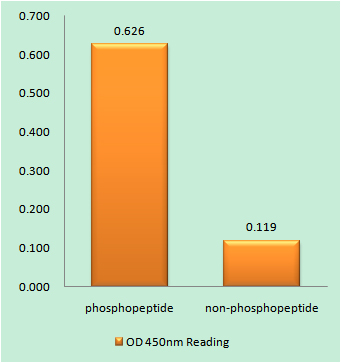Total Lck Cell-Based Colorimetric ELISA Kit
- Catalog No.:KA4160C
- Applications:ELISA
- Reactivity:Human;Mouse;Rat
- Gene Name:
- LCK
- Human Gene Id:
- 3932
- Human Swiss Prot No:
- P06239
- Mouse Swiss Prot No:
- P06240
- Rat Swiss Prot No:
- Q01621
- Storage Stability:
- 2-8°C/6 months
- Other Name:
- Tyrosine-protein kinase Lck (EC 2.7.10.2) (Leukocyte C-terminal Src kinase) (LSK) (Lymphocyte cell-specific protein-tyrosine kinase) (Protein YT16) (Proto-oncogene Lck) (T cell-specific protein-tyrosine kinase) (p56-LCK)
- Detection Method:
- Colorimetric
- Background:
- catalytic activity:ATP + a [protein]-L-tyrosine = ADP + a [protein]-L-tyrosine phosphate.,disease:A chromosomal aberration involving LCK is found in leukemias. Translocation t(1;7)(p34;q34) with TCRB.,domain:The SH2 domain mediates interaction with SQSTM1. Interaction is regulated by Ser-59 phosphorylation.,enzyme regulation:Inhibited by tyrosine phosphorylation.,function:Tyrosine kinase that plays an essential role for the selection and maturation of developing T-cell in the thymus and in mature T-cell function. Is constitutively associated with the cytoplasmic portions of the CD4 and CD8 surface receptors and plays a key role in T-cell antigen receptor(TCR)-linked signal transduction pathways. Association of the TCR with a peptide antigen-bound MHC complex facilitates the interaction of CD4 and CD8 with MHC class II and class I molecules, respectively, and thereby recruits the associated LCK to the vicinity of the TCR/CD3 complex. LCK then phosphorylates tyrosines residues within the immunoreceptor tyrosines-based activation motifs (ITAMs) in the cytoplasmic tails of the TCRgamma chains and CD3 subunits, initiating the TCR/CD3 signaling pathway. In addition, contributes to signaling by other receptor molecules. Associates directly with the cytoplasmic tail of CD2, and upon engagement of the CD2 molecule, LCK undergoes hyperphosphorylation and activation. Also plays a role in the IL2 receptor-linked signaling pathway that controls T-cell proliferative response. Binding of IL2 to its receptor results in increased activity of LCK. Is expressed at all stages of thymocyte development and is required for the regulation of maturation events that are governed by both pre-TCR and mature alpha beta TCR.,mass spectrometry: PubMed:11840567,online information:Lck entry,PTM:Phosphorylated on Tyr-394, which increases enzymatic activity (By similarity). Phosphorylated on Tyr-505, which decreases activity.,similarity:Belongs to the protein kinase superfamily. Tyr protein kinase family. SRC subfamily.,similarity:Contains 1 protein kinase domain.,similarity:Contains 1 SH2 domain.,similarity:Contains 1 SH3 domain.,subcellular location:Present in lipid rafts in an unactive form.,subunit:Binds to the cytoplasmic domain of cell surface receptors, such as CD2, CD4, CD5, CD8, CD44, CD45 and CD122. Also binds to effector molecules, such as PI4K, VAV1, RASA1, FYB and to other protein kinases including CDC2, RAF1, ZAP70 and SYK. Binds to phosphatidylinositol 3'-kinase (PI3K) from T-lymphocytes through its SH3 domain and to the tyrosine phosphorylated form of KHDRBS1/p70 through its SH2 domain. Binds to HIV-1 Nef through its SH3 domain. This interaction inhibits its tyrosine-kinase activity. Interacts with SQSTM1. Interacts with phosphorylated LIME1. Interacts with CBLB and PTPRH.,tissue specificity:Expressed specifically in lymphoid cells.,
- Function:
- cell activation, immune system development, leukocyte differentiation, positive regulation of immune system process,regulation of leukocyte activation, positive regulation of leukocyte activation, protein amino acid phosphorylation,phosphorus metabolic process, phosphate metabolic process, ion transport, cation transport, calcium ion transport,cellular ion homeostasis, cellular calcium ion homeostasis, cellular metal ion homeostasis, cellular zinc ion homeostasis,apoptosis, induction of apoptosis, activation of caspase activity, cell surface receptor linked signal transduction,elevation of cytosolic calcium ion concentration, cell death, positive regulation of signal transduction, positive regulation of cell communication, regulation of cell death, positive regulation of cell death, positive regulation of peptidase activity, programmed cell death, induction of programmed cell death, di-,
- Subcellular Location:
- Cell membrane ; Lipid-anchor ; Cytoplasmic side . Cytoplasm, cytosol . Present in lipid rafts in an inactive form. .
- Expression:
- Expressed specifically in lymphoid cells.
- June 19-2018
- WESTERN IMMUNOBLOTTING PROTOCOL
- June 19-2018
- IMMUNOHISTOCHEMISTRY-PARAFFIN PROTOCOL
- June 19-2018
- IMMUNOFLUORESCENCE PROTOCOL
- September 08-2020
- FLOW-CYTOMEYRT-PROTOCOL
- May 20-2022
- Cell-Based ELISA│解您多样本WB检测之困扰
- July 13-2018
- CELL-BASED-ELISA-PROTOCOL-FOR-ACETYL-PROTEIN
- July 13-2018
- CELL-BASED-ELISA-PROTOCOL-FOR-PHOSPHO-PROTEIN
- July 13-2018
- Antibody-FAQs


